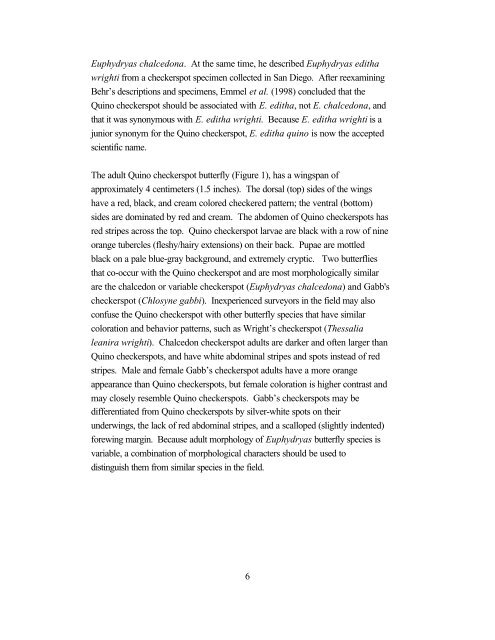Outline of Quino Recovery Plan - The Xerces Society
Outline of Quino Recovery Plan - The Xerces Society
Outline of Quino Recovery Plan - The Xerces Society
You also want an ePaper? Increase the reach of your titles
YUMPU automatically turns print PDFs into web optimized ePapers that Google loves.
Euphydryas chalcedona. At the same time, he described Euphydryas editha<br />
wrighti from a checkerspot specimen collected in San Diego. After reexamining<br />
Behr’s descriptions and specimens, Emmel et al. (1998) concluded that the<br />
<strong>Quino</strong> checkerspot should be associated with E. editha, not E. chalcedona, and<br />
that it was synonymous with E. editha wrighti. Because E. editha wrighti is a<br />
junior synonym for the <strong>Quino</strong> checkerspot, E. editha quino is now the accepted<br />
scientific name.<br />
<strong>The</strong> adult <strong>Quino</strong> checkerspot butterfly (Figure 1), has a wingspan <strong>of</strong><br />
approximately 4 centimeters (1.5 inches). <strong>The</strong> dorsal (top) sides <strong>of</strong> the wings<br />
have a red, black, and cream colored checkered pattern; the ventral (bottom)<br />
sides are dominated by red and cream. <strong>The</strong> abdomen <strong>of</strong> <strong>Quino</strong> checkerspots has<br />
red stripes across the top. <strong>Quino</strong> checkerspot larvae are black with a row <strong>of</strong> nine<br />
orange tubercles (fleshy/hairy extensions) on their back. Pupae are mottled<br />
black on a pale blue-gray background, and extremely cryptic. Two butterflies<br />
that co-occur with the <strong>Quino</strong> checkerspot and are most morphologically similar<br />
are the chalcedon or variable checkerspot (Euphydryas chalcedona) and Gabb's<br />
checkerspot (Chlosyne gabbi). Inexperienced surveyors in the field may also<br />
confuse the <strong>Quino</strong> checkerspot with other butterfly species that have similar<br />
coloration and behavior patterns, such as Wright’s checkerspot (<strong>The</strong>ssalia<br />
leanira wrighti). Chalcedon checkerspot adults are darker and <strong>of</strong>ten larger than<br />
<strong>Quino</strong> checkerspots, and have white abdominal stripes and spots instead <strong>of</strong> red<br />
stripes. Male and female Gabb’s checkerspot adults have a more orange<br />
appearance than <strong>Quino</strong> checkerspots, but female coloration is higher contrast and<br />
may closely resemble <strong>Quino</strong> checkerspots. Gabb’s checkerspots may be<br />
differentiated from <strong>Quino</strong> checkerspots by silver-white spots on their<br />
underwings, the lack <strong>of</strong> red abdominal stripes, and a scalloped (slightly indented)<br />
forewing margin. Because adult morphology <strong>of</strong> Euphydryas butterfly species is<br />
variable, a combination <strong>of</strong> morphological characters should be used to<br />
distinguish them from similar species in the field.<br />
6
















